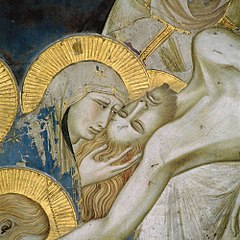
Mary, mother of Jesus
Mary[b] was a first-century Jewish woman of Nazareth,[6] the wife of Joseph and the mother of Jesus. She is a central figure of Christianity, venerated under various titles such as virgin or queen, many of them mentioned in the Litany of Loreto. The Eastern and Oriental Orthodox, Church of the East, Catholic, Anglican, and Lutheran churches believe that Mary, as mother of Jesus, is the Mother of God. Other Protestant views on Mary vary, with some holding her to have lesser status.
For the 1999 television film, see Mary, Mother of Jesus (film). For the mosque in Abu Dhabi, see Mary, Mother of Jesus Mosque.
Mary
c. 18 BC[a]
After c. 33 AD
She has the highest position in Islam among all women and is mentioned numerous times in the Quran, including in a chapter named after her.[7][8][9] She is also revered in the Baháʼí Faith and the Druze Faith.[10]
The synoptic Gospels name Mary as the mother of Jesus. The gospels of Matthew and Luke describe Mary as a virgin[c] who was chosen by God to conceive Jesus through the Holy Spirit. After giving birth to Jesus in Bethlehem, she raised him in the city of Nazareth in Galilee, and was in Jerusalem at his crucifixion and with the apostles after his ascension. Although her later life is not accounted in the Bible, Roman Catholic, Eastern Orthodox, and some Protestant traditions believe that her body was raised into heaven at the end of her earthly life, which is known in Western Christianity as the Assumption of Mary and in Eastern Christianity as the Dormition of the Mother of God.
Mary has been venerated since early Christianity,[14][15] and is often considered to be the holiest and greatest saint. There is a certain diversity in the Mariology and devotional practices of major Christian traditions. The Catholic Church holds distinctive Marian dogmas, namely her Immaculate Conception and her bodily Assumption into heaven.[16] Many Protestants hold less exalted views of Mary's role, often based on a perceived lack of biblical support for many traditional Christian dogmas pertaining to her.[17]
The multiple forms of Marian devotions include various prayers and hymns, the celebration of several Marian feast days in liturgy, the veneration of images and relics, the construction of churches dedicated to her and pilgrimages to Marian shrines. Many Marian apparitions and miracles attributed to her intercession have been reported by believers over the centuries. She has been a traditional subject in arts, notably in Byzantine art, medieval art and Renaissance art.
Mary
Christianity, Islam, Druze faith[116]
Pre-Congregation
Blue mantle, crown of 12 stars, pregnant woman, roses, woman with child, woman trampling serpent, crescent moon, woman clothed with the sun, heart pierced by sword, rosary beads



















